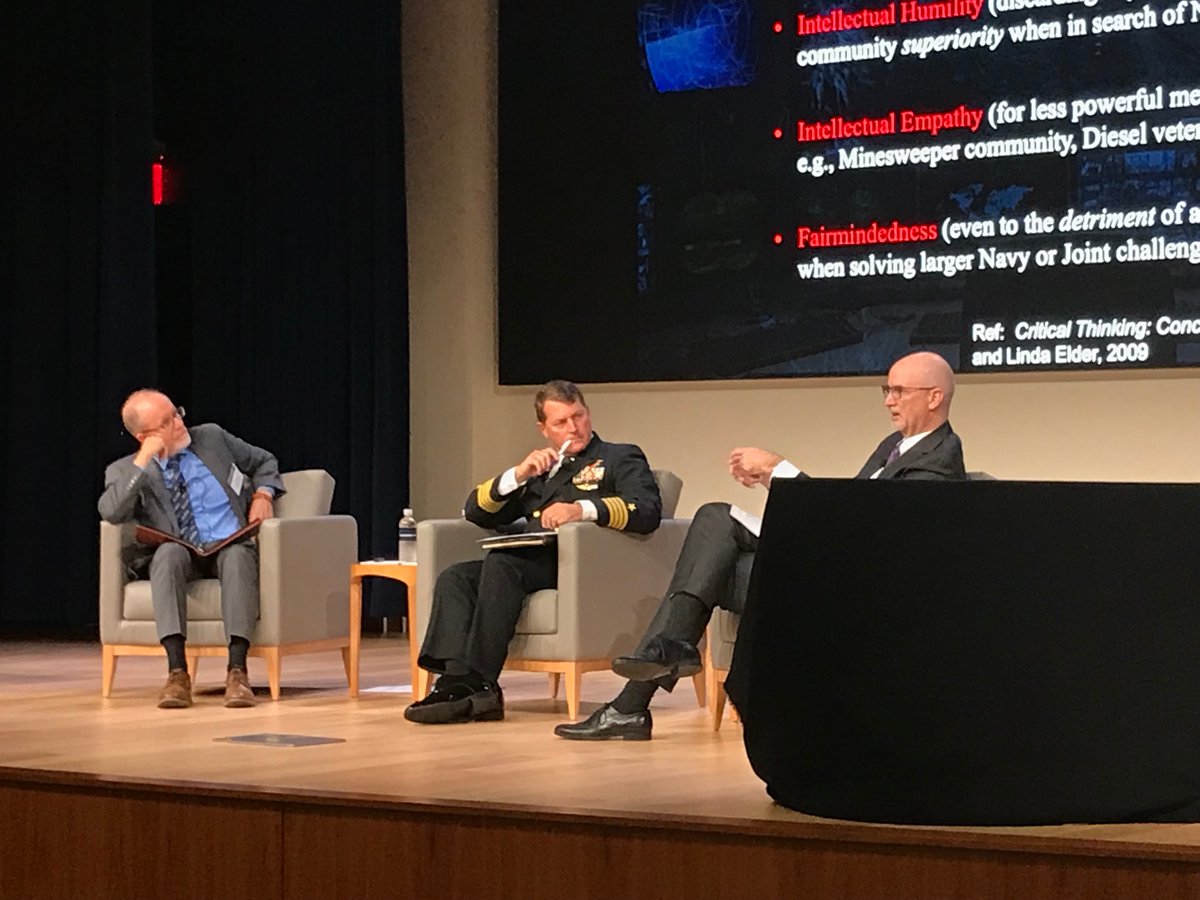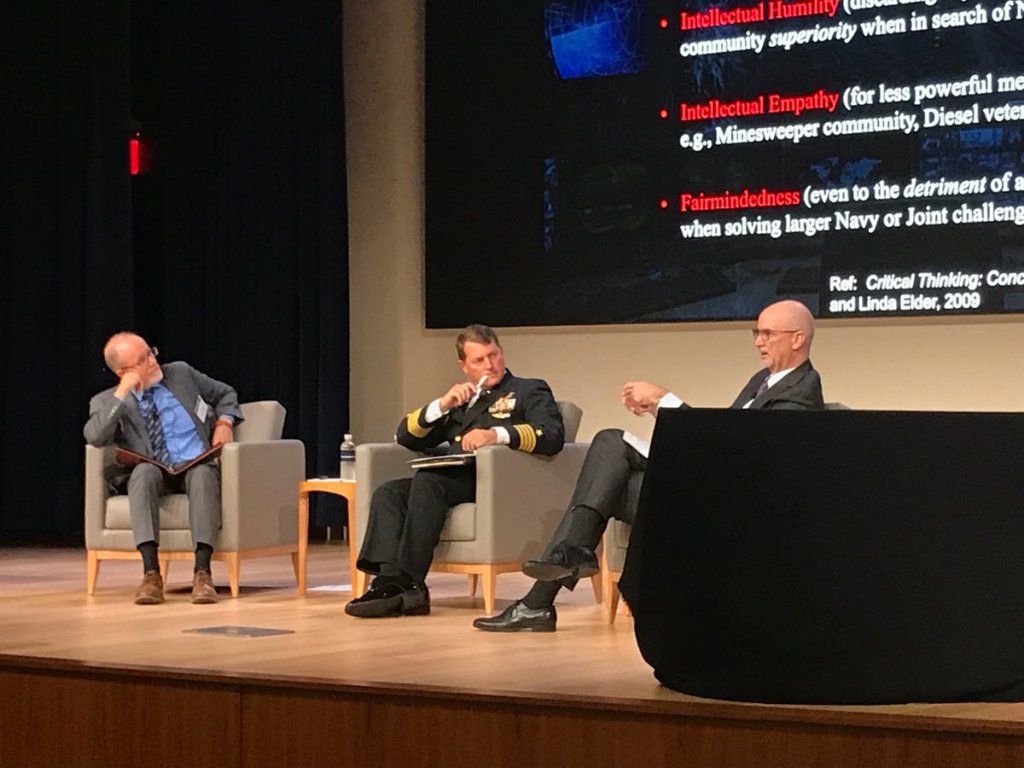
Critical Thinking
These are my remarks from the Naval Institute’s Critical Thinking Conference on 25 October 2023.

A century ago, the Navy created a learning system capable of systematically introducing new tactics, doctrines, and operational concepts. That learning system was the result of a cognitive revolution that began in the late nineteenth century. That revolution had several components:
- At the Naval War College, Alfred Thayer Mahan introduced an educational tideway based on theoretical principles that were workable regardless of changes in tactics and technology. This prompted naval officers to think critically well-nigh how weightier to wield those principles.
- The laws governing naval personnel changed, in 1899 when the line officers and engineering corps were amalgamated, and then in 1916 with the introduction of merit-based promotion. This created a personnel of young officers trained to think systematically who were motivated to showcase their talents.
- The Navy introduced a phased educational system designed to promote continual learning and prepare officers for the challenges they would squatter at various levels of writ during their career.
- And finally, the Office of the Chief of Naval Operations (OPNAV) was created in 1915. This gave the Navy something it had never had before, a staff organization that could think critically well-nigh future war and how weightier to prepare for it.
OPNAV introduced the structure that made the learning system work—the yearly exercises, like the Squadron Problems and competitions in engineering and gunnery. Throughout the 1920s and 30s, these provided a ways for officers to think critically, wield theoretical principles to specific contexts, and demonstrate their skill. Top-down direction focused energy on the most hair-trigger challenges—those involved in a Pacific War—and innovative ideas emerged from the marrow up. Without testing and refinement in exercises, the weightier ideas became the understructure for future practice and doctrine.
The result was continual improvement. Tactics, doctrine, and understanding of how weightier to fight a Pacific war all became increasingly sophisticated in the 1920s and 1930s. The Navy learned how to fight with watercraft carriers, ripened increasingly flexible tactics for major squadron action, refined its tideway to night combat, and devised new concepts for amphibious warfare. The Navy moreover integrated new technologies, like high-frequency direction finding, radar, and very upper frequency radio. As a result, the Navy of 1941 was much increasingly capable than that of 1918 and a major reason was the fact that officers had been habituated to think critically and problem-solve, both as individuals and as a team.
Admiral Chester Nimitz, who unsupportable writ of the Pacific Squadron without the raid on Pearl Harbor, began to exploit this sufficiency immediately. He turned his staff into a collaborative sensemaking organization. Within the staff, hair-trigger thinking became a group activity. Nimitz held conferences every morning to review the current state of the war, broaden situational awareness, and discuss what the latest developments might mean. This process—tempered by Nimitz’s unswayable aggressiveness—led to the rapid identification of opportunities early in the war. Nimitz and his staff were unshut to the potential that the cryptologic work of Station Hypo provided and ready to exploit it, leading to strategic victories at the battles of Coral Sea and Midway in mid-1942.
Later in the war, Nimitz and his subordinates unfurled to leverage the Navy’s learning system. In wartime, of course, the feedback mechanism changed; gainsay versus the Japanese replaced peacetime exercises. Learning took place on multiple levels. In the gainsay zone, officers experimented with new tactics and techniques. Type commands reviewed lessons, identified approaches that worked best, and issued revised doctrines. At the squadron level, Nimitz and his staff focused on broader themes. The constructive synergy between top-down direction and bottom-up innovation continued. It led to the gainsay information part-way (CIC), a new flexible playbook for squadron tactics, and a transformational tideway to theater logistics.
These improvements were necessary. By mid-1943, the rencontre confronting Nimitz and his staff was how to execute a Central Pacific offensive of unprecedented speed and power. He was given the objective of winning the war in just two years, which many reasonable planners felt was an untellable task. Fortunately, Mahan’s principles, which Nimitz and his peers embraced, emphasized the contingent nature of warfare. Opportunities—if created and seized—could hasten the end of the war.
Accordingly, Nimitz and his planners created a wayfarers plan built as a series of options. Coupled with a revolutionary tideway to amphibious thumping and the fleet’s new capabilities, the explicit use of options unliable Nimitz to make most constructive use of the nation’s industrial potential and translate it into battleground success. From the start of the offensive at the Gilbert Islands in November 1943 until the invasion of Leyte in October 1944—some six months superiority of schedule—Nimitz remained inside the Japanese visualization cycle, keeping them off wastefulness and nullifying their defensive strategies. Without Leyte, with less room to maneuver, Nimitz had fewer options, by then so did the Japanese.
 The Defence Blog
The Defence Blog